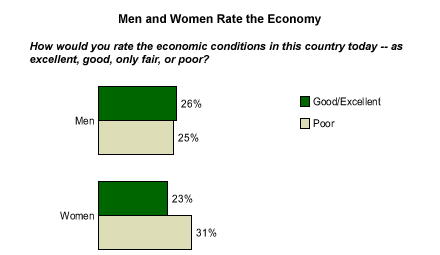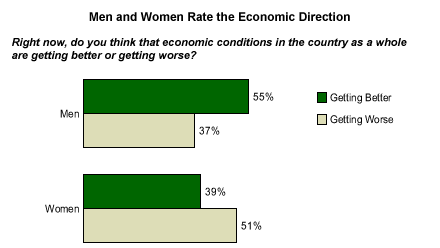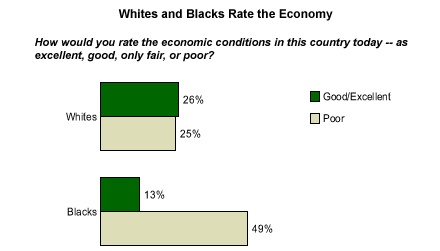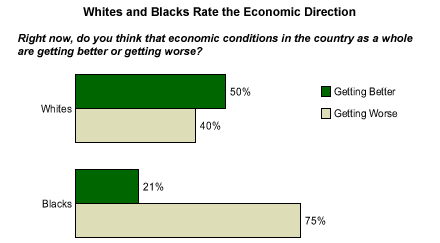Propelled by strong productivity gains and stronger business and consumer spending, the economy grew at a record pace during the third quarter. Unfortunately, not every sector of the American public is enjoying the benefits of this tremendous overall economic performance. As a result, Gallup's attitudinal economic data from two October polls (Oct. 6-8 and Oct. 24-26)* show sharp divergence in the way Americans of different genders and races view the economy and its future direction. These differences have potentially significant political and economic implications for 2004.
Men Are Optimistic, but Women Are Not
Men rate current economic conditions more positively than women do. About one in four men and women rate current economic conditions as "good" or "excellent. But while essentially the same number of men (25%) rate current economic conditions as "poor," nearly one in three women rate the current economy as poor -- thus, among women there is a significant differential (-8 percentage points) favoring the pessimistic view.

More importantly, men and women see the economy going in sharply different directions. More than half of men say economic conditions are "getting better," while only 37% say they are "getting worse" -- a differential of +18 percentage points. In sharp contrast, only 39% of women say economic conditions are getting better, while 51% say they are getting worse -- a differential of -12 percentage points.

Whites Are Optimistic, but Blacks Are Not
White Americans rate current economic conditions much more positively than black Americans do. About one in four whites rate current economic conditions as good or excellent (26%), and essentially the same number (25%) rate current economic conditions as poor a differential of +1 percentage point. At the same time, just 13% of blacks rate current economic conditions as good or excellent, while nearly half (49%) rate them as poor, a differential of -36 percentage points.

Even more significantly, whites and blacks also have significantly different opinions on the economy's direction. Half of whites say economic conditions are getting better, while 40% say they are getting worse -- a differential of +10 percentage points. In sharp contrast, only one in five blacks say economic conditions are getting better while three in four say they are getting worse -- a differential of -54 percentage points.

The Challenge for 2004
As year's end approaches, the long-delayed economic recovery from the 2001 recession seems to be underway. While no one expects the economy to continue to expand at an annual rate of 7%, most economic forecasters expect fourth quarter growth to be in the 4% range. Still, Americans seem to perceive two totally different economies. The reason for this dichotomy is the fact that this economic recovery differs significantly from those of the past -- it benefits those with higher incomes and wealth while doing little or nothing for those with lower incomes, including minorities and women who depend on a weekly paycheck for their economic well-being.
Productivity gains are driving the current economic recovery. These gains have produced significant corporate profit increases even as company top-line growth and employment have been disappointing. In turn, surging profits have produced significant stock market gains for most investors.
At the same time, interest rates have remained at historically low levels, allowing many consumers to reduce their financing burdens. Low rates have also allowed the housing market to remain very strong even as prices increase. As a result, most homeowners have home equity gains and the ability to liquefy them.
For higher-income Americans with jobs, homes, and stock portfolios, the current economy is producing significant wealth gains. As a result, these Americans have good reason to see the economy more positively than others do. And they should be much more optimistic about the future direction of the economy since a continuation of recent trends means very good things for them.
Unfortunately, the many less affluent Americans who see their economic well-being strictly in terms of their jobs and their paychecks (many of whom are single women and minorities) see a completely different economy. For them, the surge in economic growth has not produced new jobs. Instead, the drive for increased productivity has produced layoffs, wage compression, and the shipping of jobs overseas.
If the economy continues to expand through productivity and wealth gains, then Americans will continue to see two different economies. This might mean that the kind of popular unrest that triggered the California recall could spread nationwide, and possibly bring about a dramatic change in the political landscape. In turn, before policy-makers do too much celebrating about today's surging economy, they should think of ways to make sure that the benefits of the growing economy are being shared by all Americans in the year ahead.
*(NOTE: All interviews were conducted prior to the announcement of 7% GDP growth in the third quarter on Oct. 30.) Results are based on telephone interviews with 1,017 national adults, aged 18 and older, conducted Oct. 6-8, 2003, and 1,006 interviews with national adults conducted Oct. 24-26, 2003. For results based on these total samples, one can say with 95% confidence that the margin of sampling error is ±3 percentage points. Data from both October polls are combined to provide gender, race and income breakouts.

